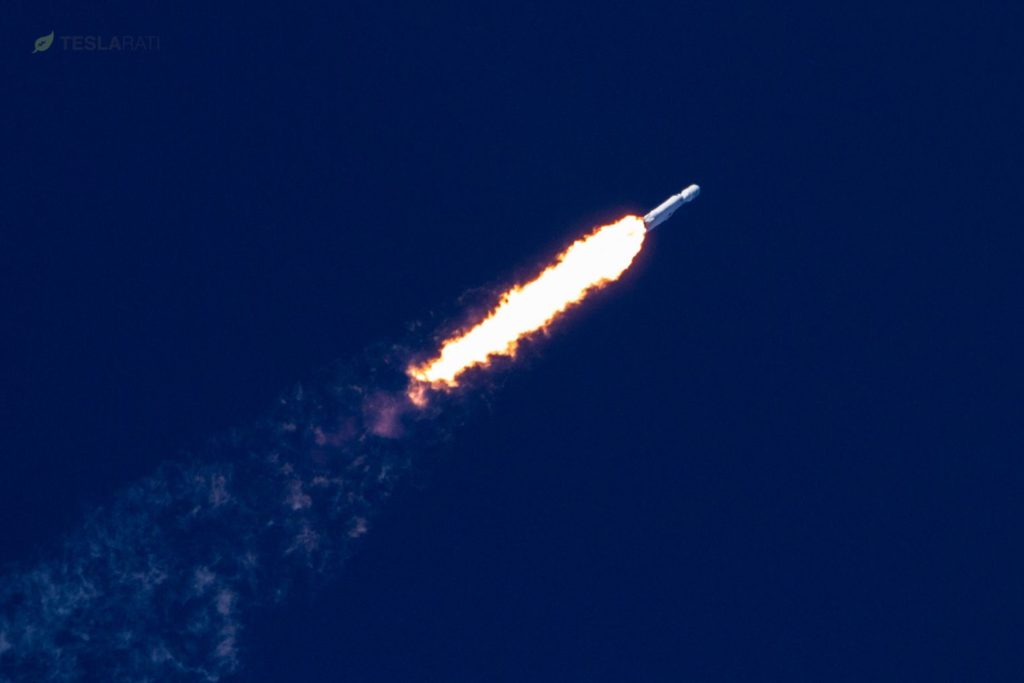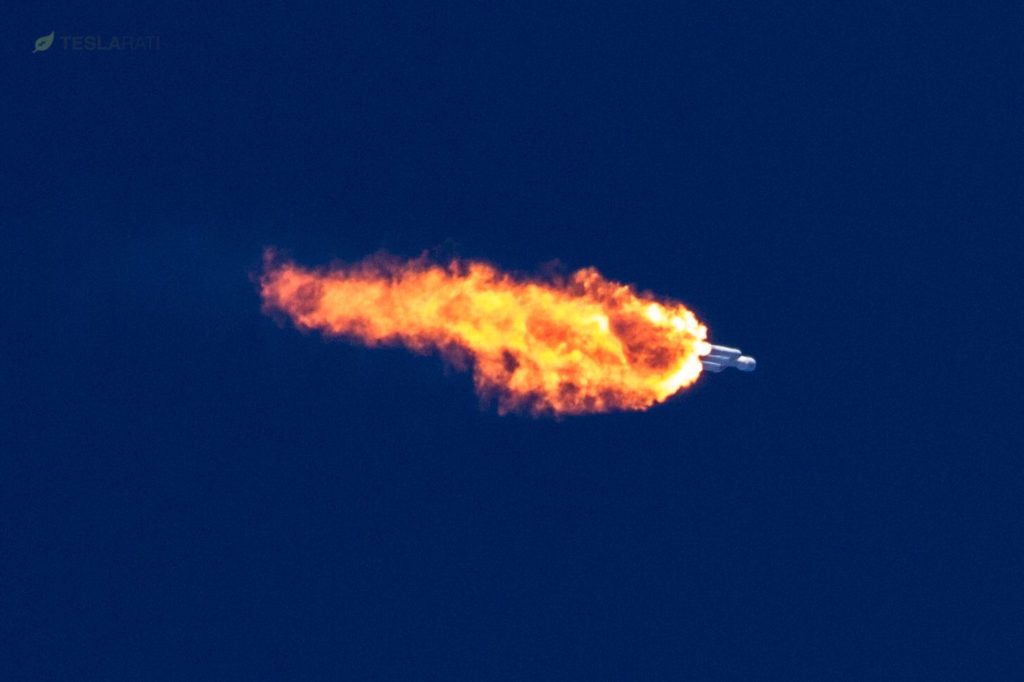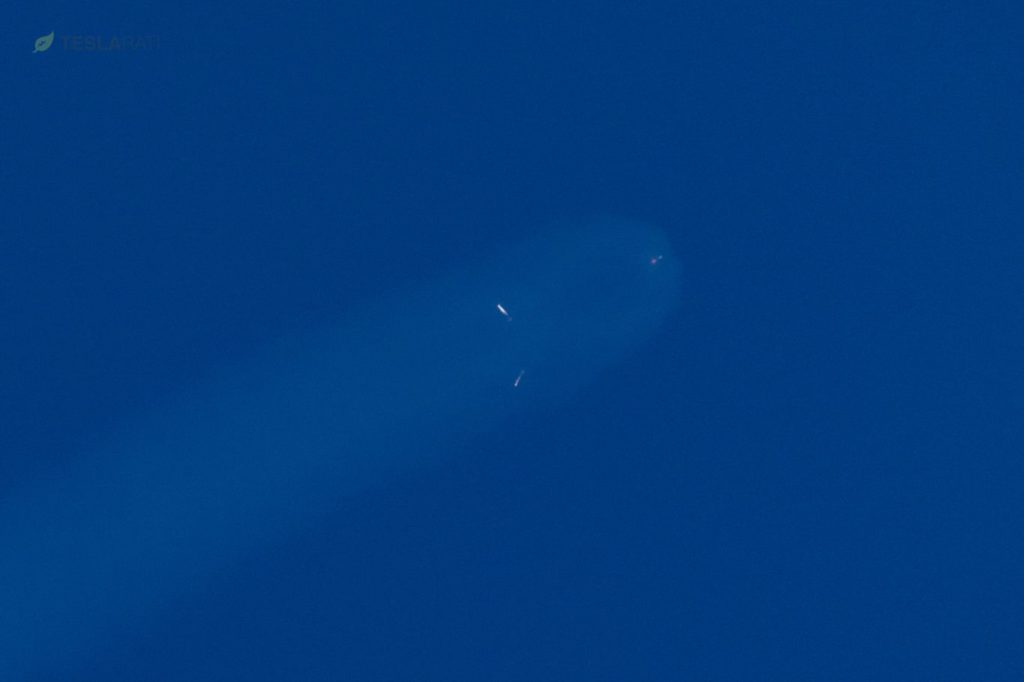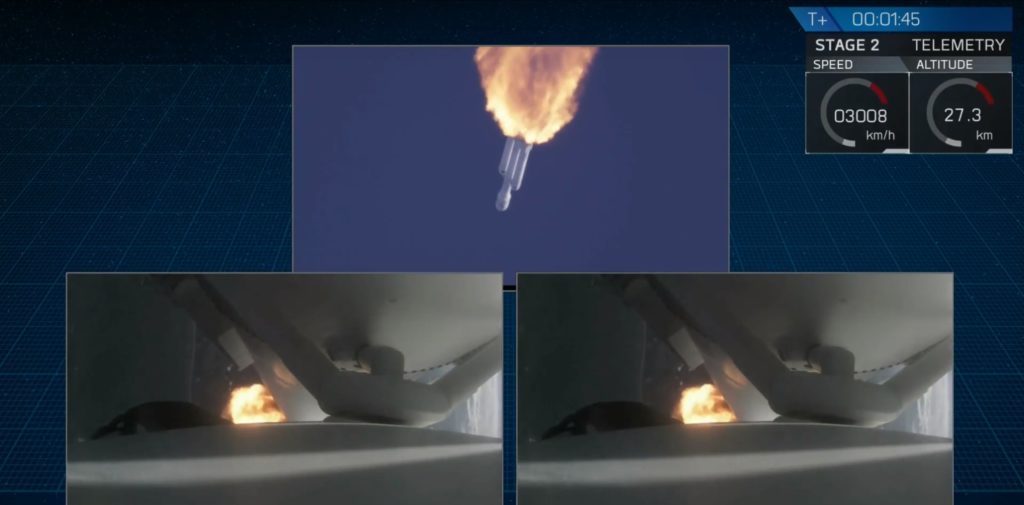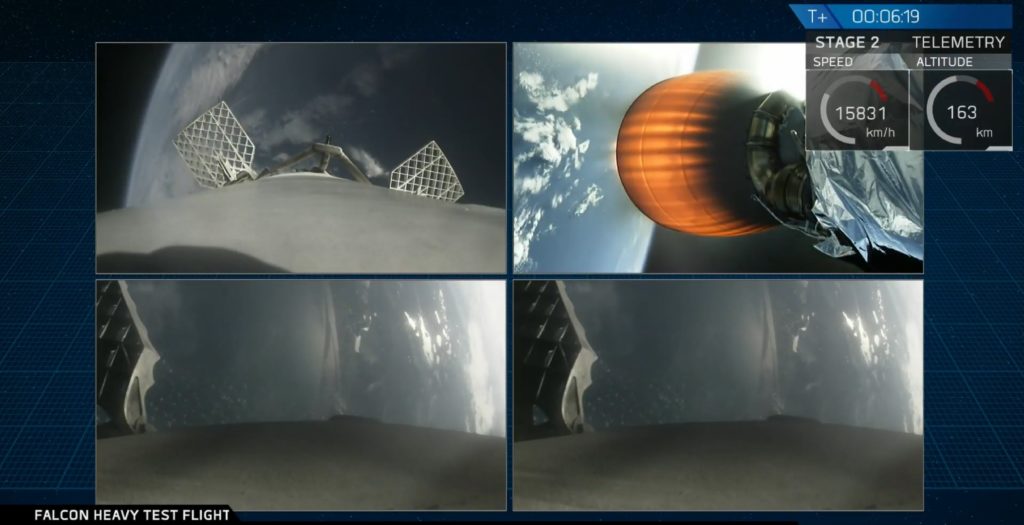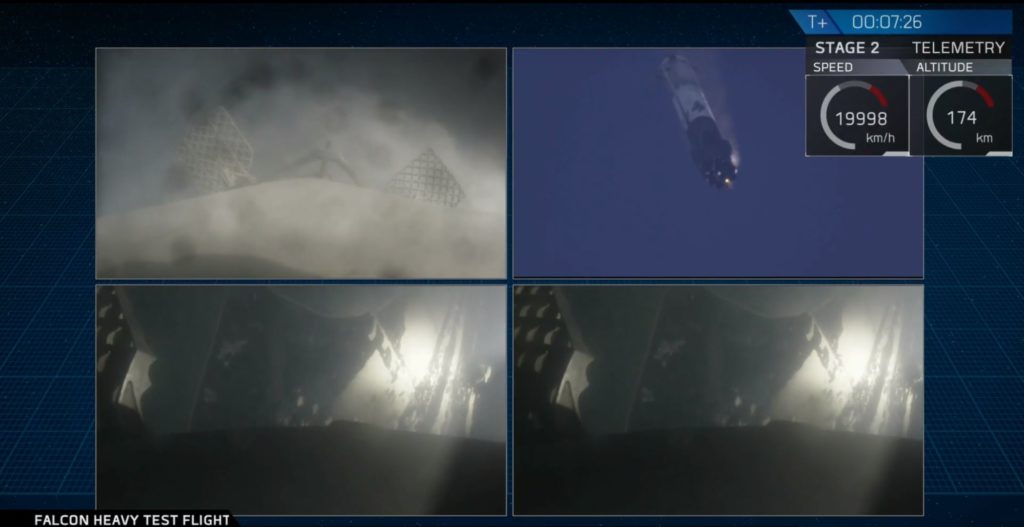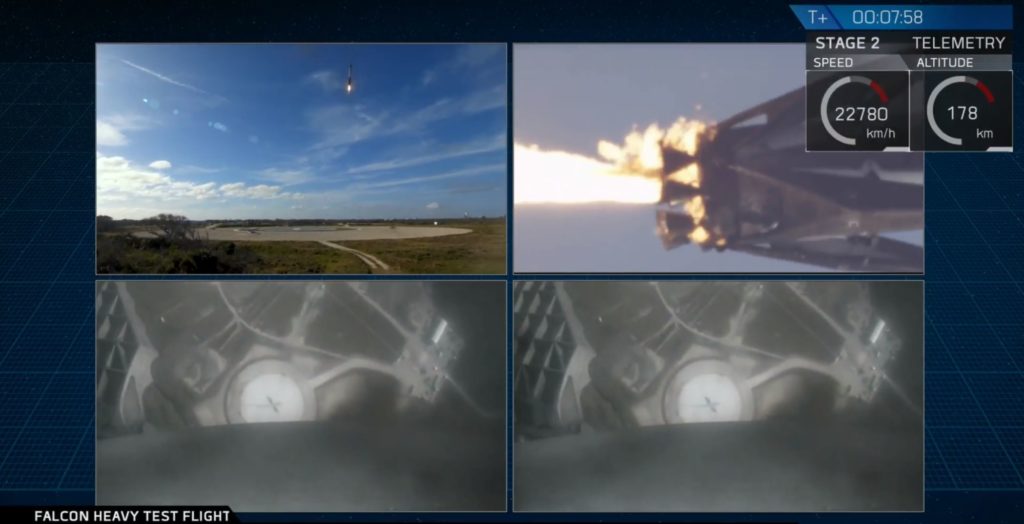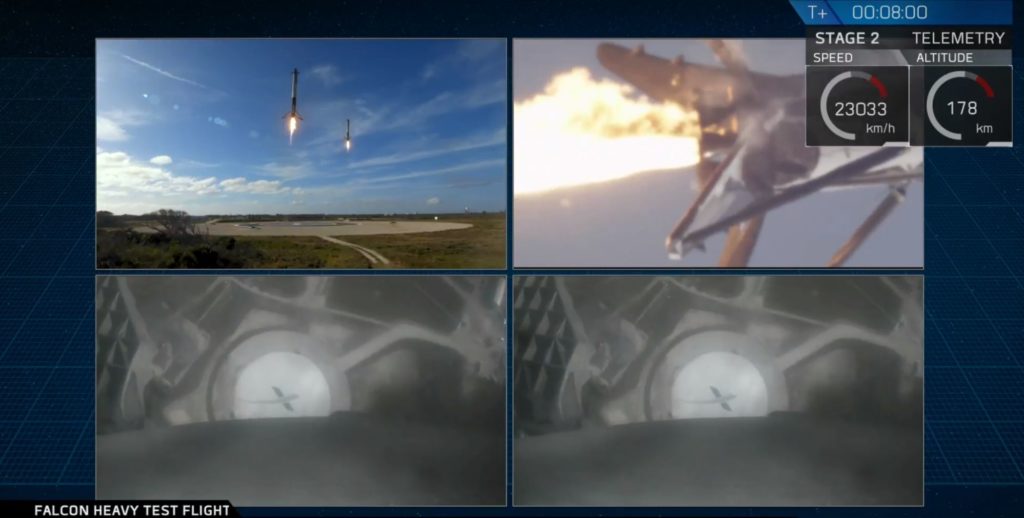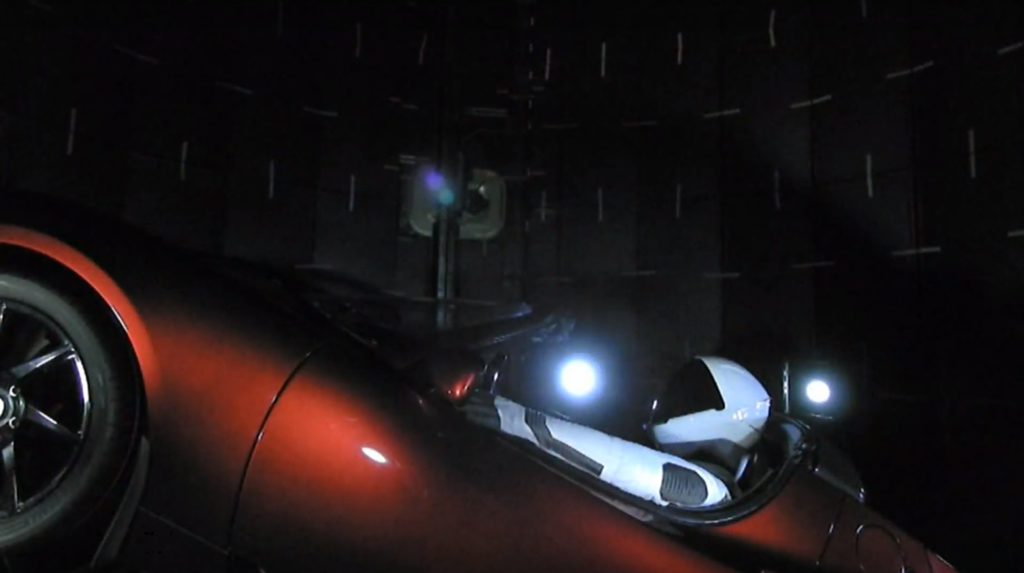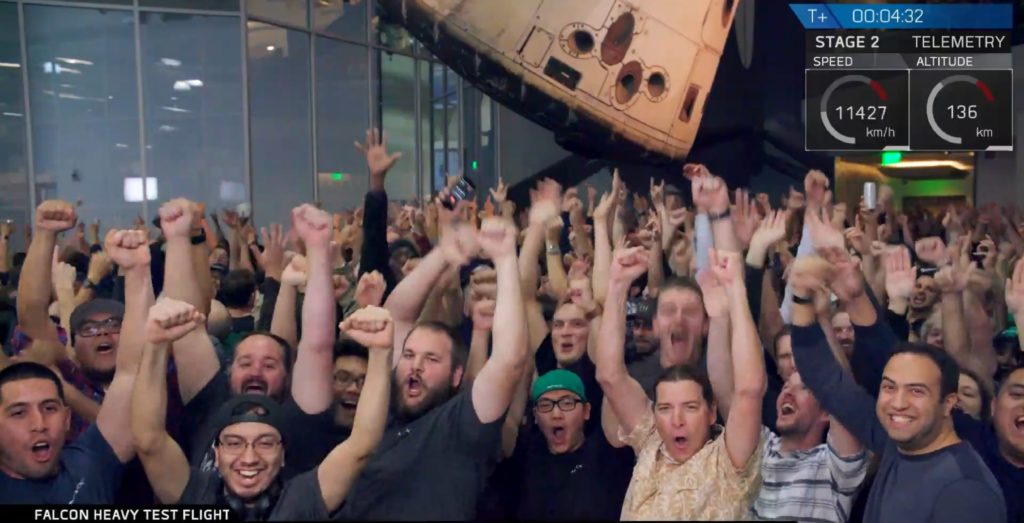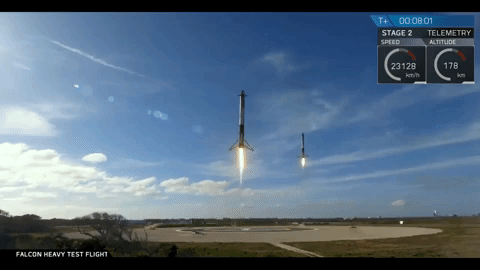

News
SpaceX stuns with two simultaneous rocket landings, Musk’s Tesla heads to Mars
In a jaw-dropping tour de force, SpaceX has successfully completed the vast majority of Falcon Heavy’s inaugural test launch. In short, the massive rocket soared through the riskiest components of its first flight with apparent ease, placing its Tesla Roadster payload into a parking orbit around Earth and landing at least two (if not all three) of its first stage boosters.
After lifting off the pad atop a fireball the likes of which Kennedy Space Center has not seen for the better part of a decade, Falcon Heavy smashed through Max-Q (peak atmospheric pressure), saw its side boosters separate perfectly, and finally sent the second stage and Tesla on its way to orbit as all three first stages began to return to land (and sea). Nearly flawless live coverage gave a million or more viewers an extraordinary ride alongside the rockets, with simultaneous views provided of all three booster recoveries, as well as the second stage’s journey to orbit.
- Falcon heavy roars towards orbit. (Tom Cross)
- As the rocket rises above Earth’s atmosphere, the rocket’s exhaust plume starts to expand. (Tom Cross)
- Finally, FH’s side boosters separate from the center core and begin their return to land. (Tom Cross)
Ultimately, the booster stages of Falcon Heavy flew back to Cape Canaveral just like any other “routine” Falcon 9 recovery, albeit with a synchronization so perfect that it looked exactly as if SpaceX had simply duplicated the live feed from one booster. After several minutes of burns and coasts, the booster returned to Earth almost simultaneously at Landing Zones 1 and 2 (LZ-1/LZ-2) in a spectacle without precedent. It’s best that I let the livestream speak for itself through screen captures – it must be witnessed to fully appreciate how incredible it was.
BEHIND THE SCENES: SpaceX Falcon Heavy’s breathtaking leap towards Mars in photos
In the background of the livestream was a near-constant stream of cheers from hundreds (probably thousands) of SpaceX’s Hawthorne factory employees, and the sheer excitement conveyed by the livestream’s hosts and SpaceXer audience was quite literally contagious – I know I was certainly grinning uncontrollably for a solid half an hour. While it is not yet clear if the center booster survived its own recovery attempt, SpaceX (or Elon Musk) will certainly provide an update as soon as possible as to its status. Fingers crossed that it managed to survive its landing aboard the autonomous spaceport drone ship (ASDS) Of Course I Still Love You (OCISLY).
- Falcon Heavy roars through Max-Q. (SpaceX)
- Side boosters separate and return back towards their landing pads. (SpaceX)
- (SpaceX)
- Landing burns begin for the side boosters! (SpaceX)
- Nearing the pads, landing legs deploy on both boosters. (SpaceX)
In the meantime, Falcon Heavy’s second stage is set to perform several orbit boosting maneuvers as it circles the Earth, eventually pushing its Roadster and Starman payload beyond Earth orbit and on its way into deep space. While it won’t end up orbiting Mars, the heliocentric (sun) orbit it will be placed in is intended to pass very close to Mars at certain points. Stay tuned as SpaceX releases additional information on the state of the center booster and the upper stage’s progress towards deep space.
Upper stage restart nominal, apogee raised to 7000 km. Will spend 5 hours getting zapped in Van Allen belts & then attempt final burn for Mars.
— Elon Musk (@elonmusk) February 6, 2018
- (SpaceX)
- Roadster and Starman in orbit. (SpaceX)
Follow along live as launch photographer Tom Cross and I cover these exciting proceedings as close to live as possible.
Teslarati – Instagram – Twitter
Tom Cross – Instagram
Eric Ralph – Twitter

Elon Musk
Elon Musk’s X will start using a Tesla-like software update strategy
The initiative seems designed to accelerate updates to the social media platform, while maintaining maximum transparency.

Elon Musk’s social media platform X will adopt a Tesla-esque approach to software updates for its algorithm.
The initiative seems designed to accelerate updates to the social media platform, while maintaining maximum transparency.
X’s updates to its updates
As per Musk in a post on X, the social media company will be making a new algorithm to determine what organic and advertising posts are recommended to users. These updates would then be repeated every four weeks.
“We will make the new 𝕏 algorithm, including all code used to determine what organic and advertising posts are recommended to users, open source in 7 days. This will be repeated every 4 weeks, with comprehensive developer notes, to help you understand what changed,” Musk wrote in his post.
The initiative somewhat mirrors Tesla’s over-the-air update model, where vehicle software is regularly refined and pushed to users with detailed release notes. This should allow users to better understand the details of X’s every update and foster a healthy feedback loop for the social media platform.
xAI and X
X, formerly Twitter, has been acquired by Elon Musk’s artificial intelligence startup, xAI last year. Since then, xAI has seen a rapid rise in valuation. Following the company’s the company’s upsized $20 billion Series E funding round, estimates now suggest that xAI is worth tens about $230 to $235 billion. That’s several times larger than Tesla when Elon Musk received his controversial 2018 CEO Performance Award.
As per xAI, the Series E funding round attracted a diverse group of investors, including Valor Equity Partners, Stepstone Group, Fidelity Management & Research Company, Qatar Investment Authority, MGX, and Baron Capital Group, among others. Strategic partners NVIDIA and Cisco Investments also continued support for building the world’s largest GPU clusters.
News
Tesla FSD Supervised wins MotorTrend’s Best Driver Assistance Award
The decision marks a notable reversal for the publication from prior years, with judges citing major real-world improvements that pushed Tesla’s latest FSD software ahead of every competing ADAS system.

Tesla’s Full Self-Driving (Supervised) system has been named the best driver-assistance technology on the market, earning top honors at the 2026 MotorTrend Best Tech Awards.
The decision marks a notable reversal for the publication from prior years, with judges citing major real-world improvements that pushed Tesla’s latest FSD software ahead of every competing ADAS system. And it wasn’t even close.
MotorTrend reverses course
MotorTrend awarded Tesla FSD (Supervised) its 2026 Best Tech Driver Assistance title after extensive testing of the latest v14 software. The publication acknowledged that it had previously criticized earlier versions of FSD for erratic behavior and near-miss incidents, ultimately favoring rivals such as GM’s Super Cruise in earlier evaluations.
According to MotorTrend, the newest iteration of FSD resolved many of those shortcomings. Testers said v14 showed far smoother behavior in complex urban scenarios, including unprotected left turns, traffic circles, emergency vehicles, and dense city streets. While the system still requires constant driver supervision, judges concluded that no other advanced driver-assistance system currently matches its breadth of capability.
Unlike rival systems that rely on combinations of cameras, radar, lidar, and mapped highways, Tesla’s FSD operates using a camera-only approach and is capable of driving on city streets, rural roads, and freeways. MotorTrend stated that pure utility, the ability to handle nearly all road types, ultimately separated FSD from competitors like Ford BlueCruise, GM Super Cruise, and BMW’s Highway Assistant.
High cost and high capability
MotorTrend also addressed FSD’s pricing, which remains significantly higher than rival systems. Tesla currently charges $8,000 for a one-time purchase or $99 per month for a subscription, compared with far lower upfront and subscription costs from other automakers. The publication noted that the premium is justified given FSD’s unmatched scope and continuous software evolution.
Safety remained a central focus of the evaluation. While testers reported collision-free operation over thousands of miles, they noted ongoing concerns around FSD’s configurable driving modes, including options that allow aggressive driving and speeds beyond posted limits. MotorTrend emphasized that, like all Level 2 systems, FSD still depends on a fully attentive human driver at all times.
Despite those caveats, the publication concluded that Tesla’s rapid software progress fundamentally reshaped the competitive landscape. For drivers seeking the most capable hands-on driver-assistance system available today, MotorTrend concluded Tesla FSD (Supervised) now stands alone at the top.
News
Elon Musk’s Grokipedia surges to 5.6M articles, almost 79% of English Wikipedia
The explosive growth marks a major milestone for the AI-powered online encyclopedia, which was launched by Elon Musk’s xAI just months ago.

Elon Musk’s Grokipedia has grown to an impressive 5,615,201 articles as of today, closing in on 79% of the English Wikipedia’s current total of 7,119,376 articles.
The explosive growth marks a major milestone for the AI-powered online encyclopedia, which was launched by Elon Musk’s xAI just months ago. Needless to say, it would only be a matter of time before Grokipedia exceeds English Wikipedia in sheer volume.
Grokipedia’s rapid growth
xAI’s vision for Grokipedia emphasizes neutrality, while Grok’s reasoning capabilities allow for fast drafting and fact-checking. When Elon Musk announced the initiative in late September 2025, he noted that Grokipedia would be an improvement to Wikipedia because it would be designed to avoid bias.
At the time, Musk noted that Grokipedia “is a necessary step towards the xAI goal of understanding the Universe.”
Grokipedia was launched in late October, and while xAI was careful to list it only as Version 0.1 at the time, the online encyclopedia immediately earned praise. Wikipedia co-founder Larry Sanger highlighted the project’s innovative approach, noting how it leverages AI to fill knowledge gaps and enable rapid updates. Netizens also observed how Grokipedia tends to present articles in a more objective manner compared to Wikipedia, which is edited by humans.
Elon Musk’s ambitious plans
With 5,615,201 total articles, Grokipedia has now grown to almost 79% of English Wikipedia’s article base. This is incredibly quick, though Grokipedia remains text-only for now. xAI, for its part, has now updated the online encyclopedia’s iteration to v0.2.
Elon Musk has shared bold ideas for Grokipedia, including sending a record of the entire knowledge base to space as part of xAI’s mission to preserve and expand human understanding. At some point, Musk stated that Grokipedia will be renamed to Encyclopedia Galactica, and it will be sent to the cosmos.
“When Grokipedia is good enough (long way to go), we will change the name to Encyclopedia Galactica. It will be an open source distillation of all knowledge, including audio, images and video. Join xAI to help build the sci-fi version of the Library of Alexandria!” Musk wrote, adding in a later post that “Copies will be etched in stone and sent to the Moon, Mars and beyond. This time, it will not be lost.”
